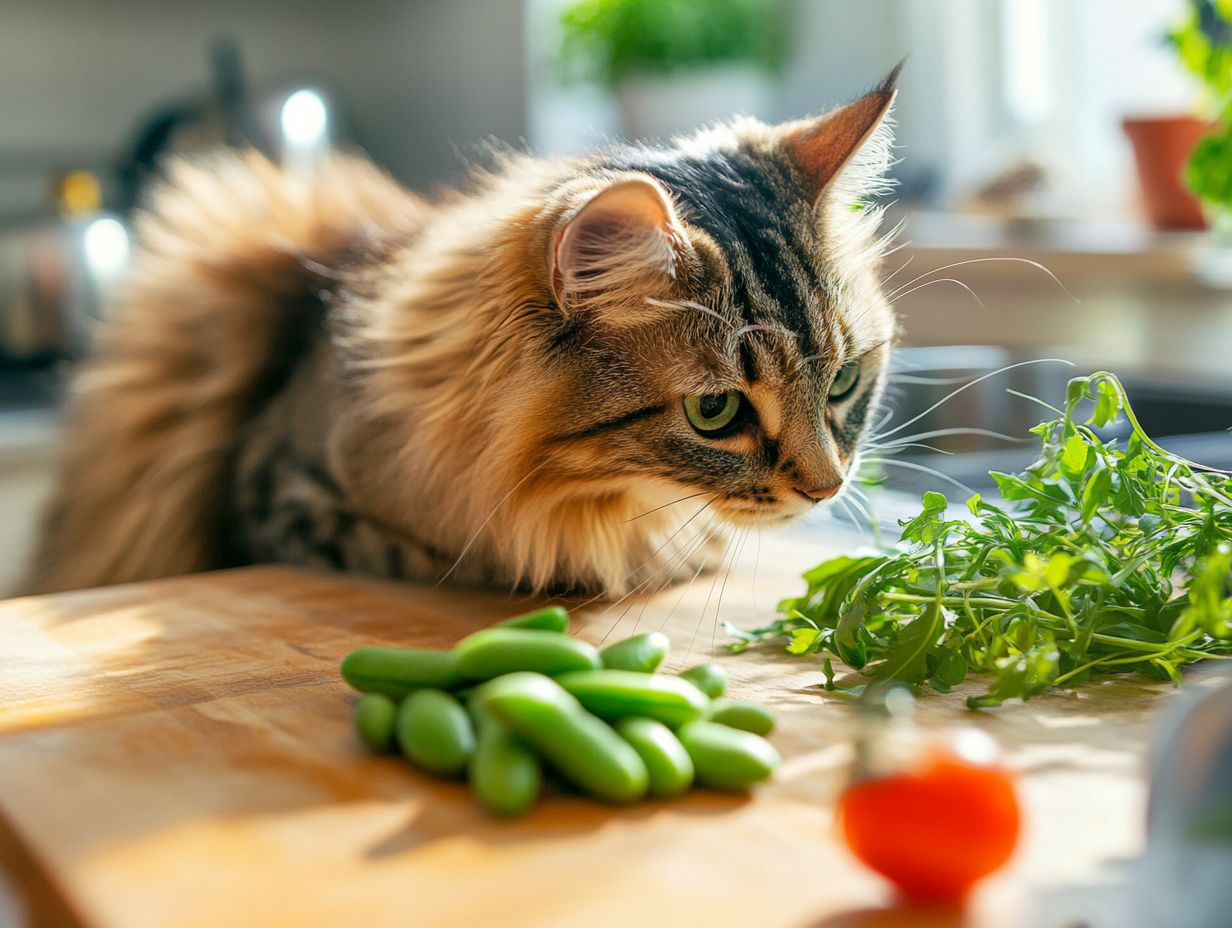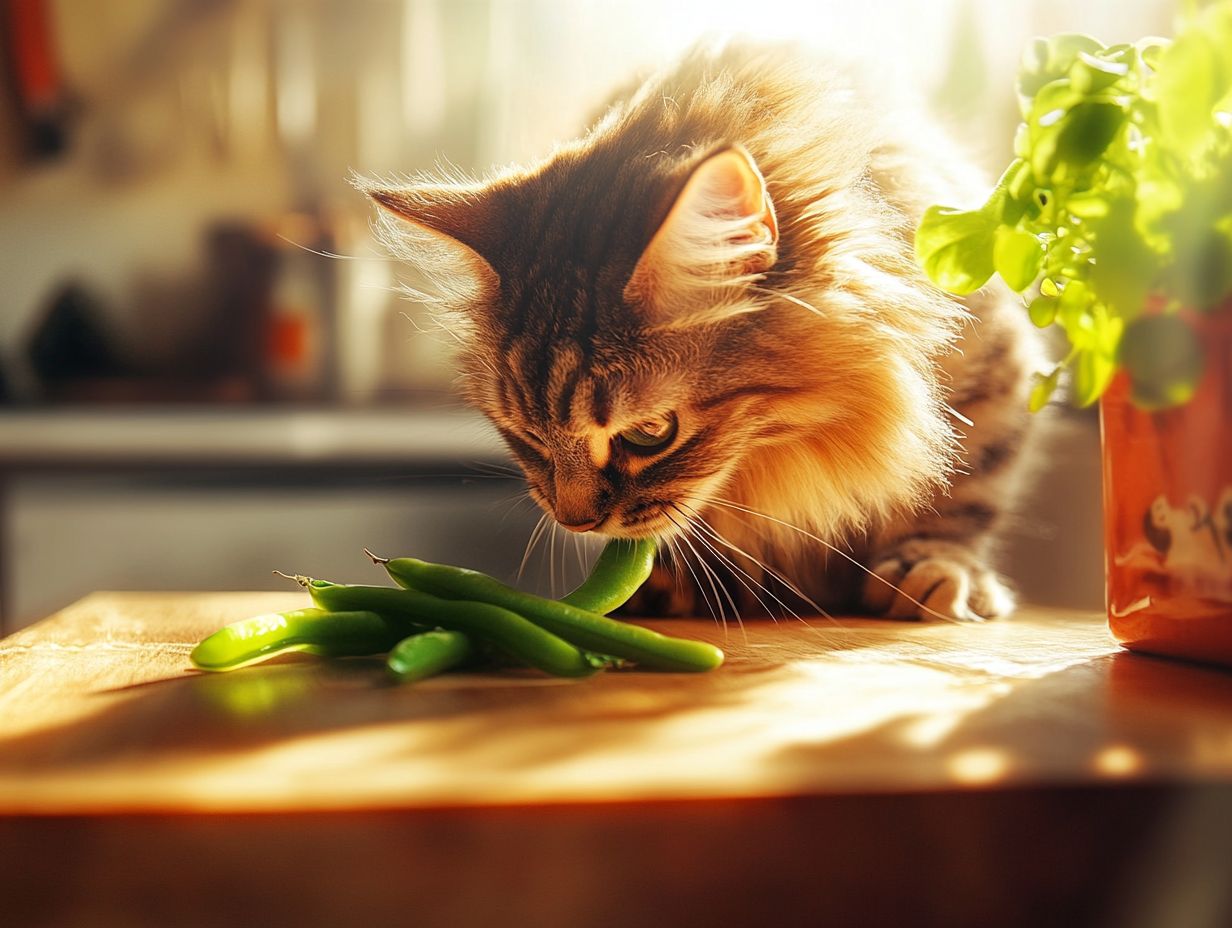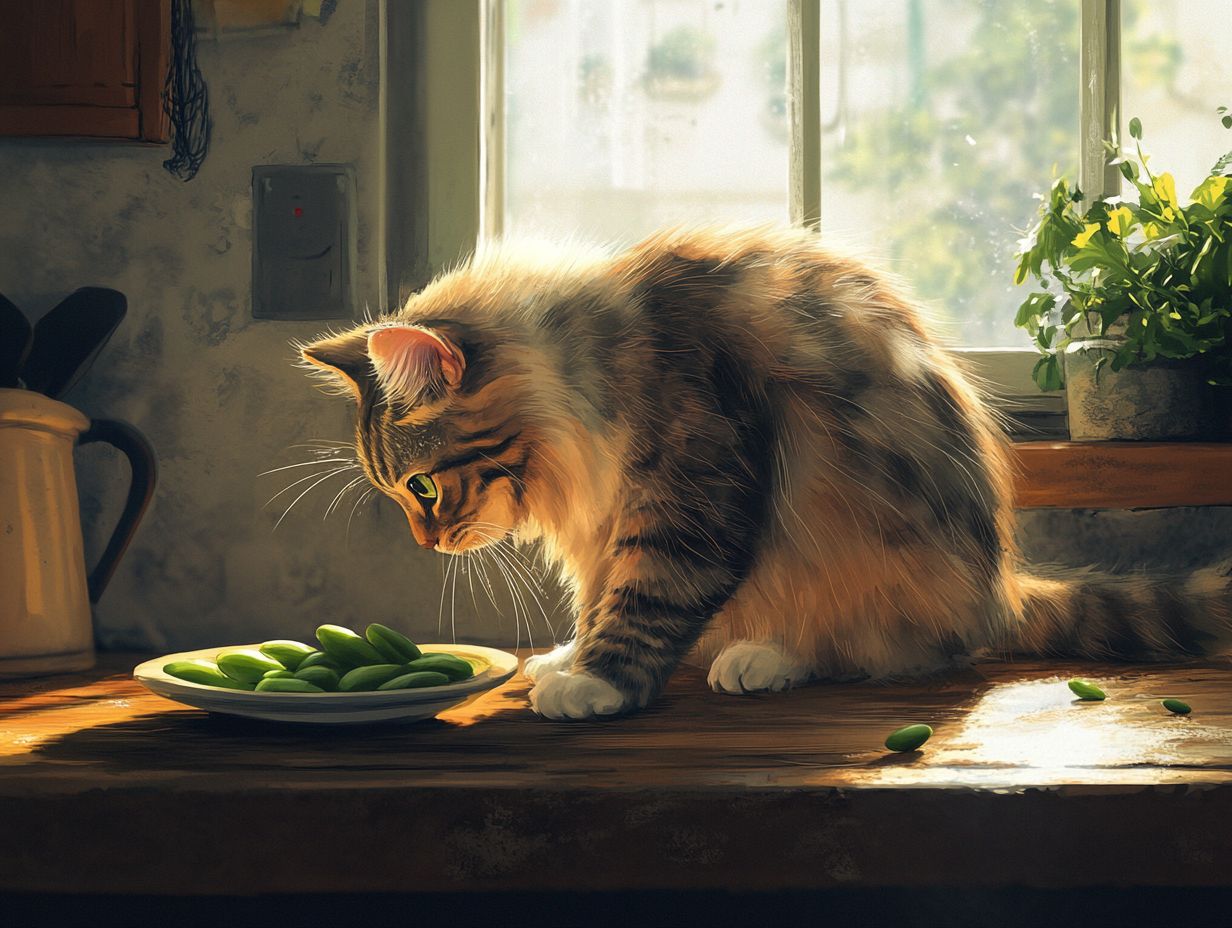Curious about whether your feline friend can munch on green beans? These can be a healthy snack for cats! This article explores the benefits of green beans, potential risks, and how to safely incorporate them into your cat’s diet with veterinary recommendations.
Additionally, we will share alternative veggies that can offer extra health perks for your furry companion, including vegetable protein options! Read on to discover if green beans are a tasty and nutritious addition to your cat’s meals.
Key Takeaways:

- Cats can safely eat green beans, which provide health benefits due to their nutritional value, including essential micronutrients like vitamin K.
- Incorporating green beans into a cat’s diet can aid in weight management and digestive health.
- Consult with a veterinarian and monitor for any adverse effects when adding new foods like green beans.
- Green beans should not exceed 10% of your cat’s daily calorie intake.
Overview of Cats and Green Beans
Cats primarily require animal-based proteins to meet their nutritional needs but can enjoy some vegetables like green beans in moderation. These can serve as a healthy snack and source of vegetable protein.
Understanding how green beans fit into a cat’s diet is crucial for pet owners who want to diversify their cat’s meals. Green beans are low in calories and high in fiber, making them an excellent choice for picky eaters who need to maintain a healthy weight.
It’s essential to follow veterinary recommendations when introducing new foods. Start by offering a small piece of cooked green bean to see how your cat reacts.
Can Cats Eat Green Beans?
Yes, cats can eat green beans—both cooked and raw—in moderation. Many vets recommend these veggies for their low calorie and high fiber content, which can aid digestion and assist with weight loss.
Cooked green beans, especially when steamed without seasoning, are easy for cats to chew. If feeding raw green beans, they should be cut into small pieces to minimize choking risks.
Introduce these treats gradually, and discuss portion sizes with your veterinarian. A suggested portion could be 1-2 green beans per serving, given a few times a week.
Health Benefits of Green Beans for Cats
Green beans are a healthy option for cats as they meet dietary needs while being low in calories and high in fiber. They are rich in essential micronutrients, including vitamin K, which promotes digestive health and supports a healthy urinary tract.
These veggies are particularly beneficial for overweight cats or those prone to urinary tract infections, as they provide a nutritious supplement without adding extra calories.
Nutritional Value and Potential Benefits

Green beans supply essential minerals like calcium, potassium, and iron, vital for overall cat health. Micronutrients such as thiamin and folate enhance their health benefits, supporting well-being.
These vitamins and minerals support energy metabolism and proper nerve function, contributing to a healthy immune response. In contrast to commercial cat treats that often contain high levels of fats and sugars, green beans provide a low-calorie, nutrient-dense option.
This makes them an excellent addition to a cat’s diet, promoting weight management while delivering beneficial antioxidants. Additionally, the fiber content aids digestive health, ensuring that cats feel satisfied without excessive calorie intake.
How to Incorporate Green Beans into a Cat’s Diet
When introducing green beans, monitor for gastrointestinal upset or any adverse reactions, and always consult with your vet for personalized advice. Signs to watch for include behavioral changes, lethargy, or any unusual reactions.
In conclusion, green beans can be a beneficial addition to your cat’s diet when introduced safely and in moderation. Always ensure you are making informed decisions regarding your pet’s food.
Green beans can be a healthy supplement to a cat’s diet when prepared properly. They offer potential benefits such as aiding in weight management and providing essential fiber. However, they should not be a primary food source and should always be introduced in moderation. It’s important to introduce green beans gradually and in appropriate amounts to meet your pet’s specific dietary needs without overwhelming them.
You can try adding small amounts of finely chopped, cooked green beans to your cat’s daily dry or wet food, or serving them as a separate snack. For an average 10-pound cat, start with 1 teaspoon of green beans to see how well your cat accepts them.
How to Prepare and Serve Green Beans to Your Cat
According to the ASPCA, these vegetables can be served either raw or cooked; however, lightly cooking them can enhance digestibility without sacrificing nutrients. They should be cut into small pieces and offered as an occasional treat or mixed in with regular food in appropriate serving sizes. Ensure that the vegetables are fresh and properly cleaned to remove any pesticides or contaminants before preparing them for your cat.
If you choose to serve them cooked, lightly steaming, boiling, or pureeing can help soften them while preserving important nutrients. As a general guideline for serving size, these vegetables should only be given in limited quantities, especially for smaller cats, who may only require a few pieces at a time. Observing your feline friend’s reaction after introducing green beans in small portions can help ease them into new foods while maintaining a balanced diet.
Potential Risks of Feeding Green Beans to Cats
Yes, green beans can be a healthy option for cats; however, there are risks and potential negative side effects that pet owners should be aware of, especially for finicky eaters. Green beans should be offered to cats in moderation, as too many green beans can upset your cat’s stomach or disrupt a cat’s typical meat-based diet.
Possible Adverse Effects

- Digestive discomfort leading to vomiting or diarrhea, especially if they are not accustomed to high-fiber foods.
- Allergic reactions or sensitivities, including itching, skin irritations, or lethargy.
- Potential contribution to obesity if not portioned correctly.
If your cat shows signs of an allergic reaction, such as itching or vomiting, stop feeding green beans immediately and consult your veterinarian. As with any new food, pet owners should monitor their cats closely after introduction, watching for changes in behavior or signs of distress.
If a cat shows persistent vomiting or unusual lethargy, it is crucial to consult a veterinarian to rule out more serious issues. Regular veterinary visits can help manage dietary changes and assist in detecting and preventing potential problems before they arise.
Alternative Vegetables for Cats
If green beans are not suitable for your cat, there are numerous other vegetables that can be offered as nutritious additions to their diet. These alternatives can provide various health benefits and cater to picky eaters who may prefer different tastes and textures in their meals.
Other Nutritious Options for Feline Diets
Nutritious options for feline diets include vegetables such as carrots, peas, and pumpkin, which can also serve as healthy treats. Each of these vegetables offers unique benefits, providing essential vitamins and minerals that support a cat’s overall health, much like green beans do.
Incorporating a variety of veggies can enhance a cat’s diet, ensuring they receive a broader spectrum of nutrients. For example, carrots are rich in beta-carotene, which promotes good vision and contributes to a healthy coat, while peas offer a source of protein as well as vitamins A and K.
Pumpkin, known for its fiber content, can aid digestion and support urinary health. Pet owners should consider steaming, pureeing, or mixing these vegetables into regular meals to make them more palatable, serving them as occasional snacks.
By introducing these nutritious options, cat owners can help maintain their feline companions’ energy levels and overall well-being.
According to experts like Dr. Linda Simon and Leslie Ingraham, feeding green beans to cats can be beneficial when done correctly. Always introduce new foods slowly and consult your vet if you have concerns about your cat’s diet.
Frequently Asked Questions
Can Cats Eat Green Beans?

Wondering if green beans are a safe treat for your feline friend? Yes, cats can enjoy green beans in moderation, but they shouldn’t replace their regular diet. Green beans can be a healthy addition to your cat’s snacks when prepared correctly.
What are the health benefits of green beans for cats?
Green beans are a good source of fiber, vitamins A and C, and minerals, which can promote digestive health and overall well-being in cats. Vitamin A supports vision and immune function, while Vitamin C acts as an antioxidant, helping to reduce inflammation and support the immune system.
How should I prepare green beans for my cat?
Green beans should be cooked before feeding them to your cat. Cook them by boiling, steaming, or pureeing without any salt or seasoning, as this removes any potential harmful bacteria or pesticides while ensuring they’re safe for your cat to enjoy.
Can green beans be harmful to cats?
Green beans are generally safe for cats to eat, but they should not be given in large quantities—typically more than 1-2 tablespoons at a time. Overfeeding green beans can lead to digestive issues such as diarrhea or constipation.
Are there any potential risks of feeding green beans to cats?
While green beans are generally safe for cats, some may have allergies or sensitivities to them. Signs of an allergic reaction can include vomiting, lethargy, or diarrhea. It’s best to introduce green beans slowly and monitor your cat’s reaction before making it a regular part of their diet.
Can green beans be a substitute for cat food?
No, green beans should not be used as a substitute for cat food. According to Dr. Linda Simon and PangoVet, cats need meat in their diet. Green beans are low in calories and high in fiber, but they do not provide all the necessary nutrients, such as protein and vitamin K, that cats need. Experts like Leslie Ingraham emphasize the importance of a proper diet for cats, which must meet all their nutritional needs.
In conclusion, green beans can be a healthy addition to your cat’s diet in moderation, but always prioritize their main nutritional needs.
